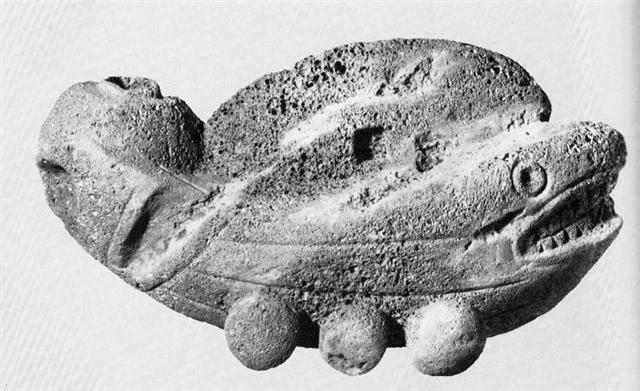4. The pentagonal form of the 'head' of Cetus made me realize why such a form could have been integrated in the tail of the stone 'whale' found on Easter Island (cfr at Parehe):
... The image is that of a reed boat with a whale's or sea monster's head at the bow, and a skull-like mask at the stern. At the top of the stern is a five-sided umu, or Easter Island fireplace, and on deck is a hare paenga, or lenticular reed house, with a square doorway on the starboard side. On the same side, a wide channel surrounded by a V-shaped groove leads down from the deck aft ... The V-shaped groove could correspond to the V of Pisces (and possibly also allude to the V between Caph and Cih in Cassiopeia). V means Latin 5 (as in fire). The hare paega on the back presumably signifies the dark 'night' side, winter (and the habitat of the sea monster). His eyes (not her this time) are drawn with double rims - they are 'watery'. I think it is Sun who is going down below the 'surface', not the sea monster, it is atumn equinox and not spring equinox. South of the equator Cetus will rise heliacally just beyond autumn equinox. Thus it ought to signify how the 'world' is sinking down into the 'sea' again, not how 'land' is reappearing. Therefore the head should be down in the sea and the top of the tail be the last part sinking down. Deneb Kaitos could mark the snout of the sinking Sun fish and Menkar (α Ceti) could be his last part, the earth oven (umu):
Puo in Gb8-8 is the same as puo in Gb8-30, maybe indicating that the last part of side b covers 472 - 449 = 23 glyphs. Then follows a tagata and a strongly drawn sign of inversion, with 3 feathers above and 3 below. There are 5 weeks from Deneb Kaitos to Menkar:
Or maybe we should say 36 days from Gb7-8 to Gb8-12. These two glyphs could be related. In principle the top of Gb8-12 is a vero sign, but its soft form makes me think 'sky roof without any light'. It would agree with the empty hand stretching high immediately before. The fish in Gb7-10 is perhaps referring to Cetus, and we should notice that it has a companion somewhat later (Gb7-15):
This one has a single feather inside and possibly also the crescent fin outside at left means 'no light'. There is, however, nothing immediately obvious in the glyphs above which can be used as evidence for a correspondence between them and the Cetus stars. Furthermore, we should not forget the perspective which Achird and Achir (Regulus) has given us. We must think on more than one level at a time. When in spring land reappears with Regulus it should be preceded by the reversal of Cetus, and the open hand stretching high is similar to, but not the same as in Gb8-11:
I guess hau tea at left in Ga4-5 refers to the light from Moon in contrast to the light from Sun, which presumably is represented by the vai type of glyph:
Probably the straight arm (in Ga4-5) in spring is pushing the sky roof high. The thumb is like the spur of a cock. In autumn the not quite so straight arm (in Gb8-11) could be keeping the sky roof high, but the thumb is different - it is not Spring Sun who is doing it. Vai at left in Gb8-11 has 4 'crescent fins', the normal number for vai. And the 'fin' at bottom right is drawn so as to prevent light from entering. Only one of the vai glyphs in G has it uplifted, and it is also the only vai with 3 'fins' (probably a sign for spring, the season of Mars):
|
|||||||||||||||||||||||||||||||||||||||||||||||||||||||||||||||||||||||||||||||||||||||||||||||||||||||||||||










